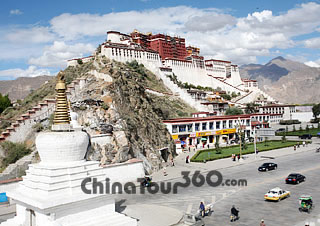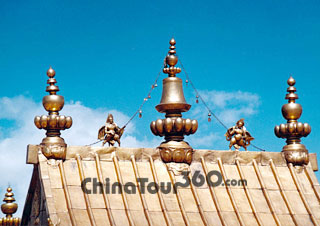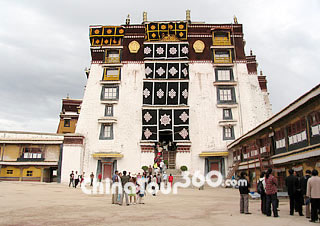 Full View of Potala Palace
Full View of Potala Palace Golden Roof of the Red Palace
Golden Roof of the Red Palace Prayer Wheels Around the East Gate
Prayer Wheels Around the East Gate The White Palace in Potala
The White Palace in Potala
Perched upon Hongshan Hill, the Potala Palace is the greatest monumental structure in all of Tibet. Early legends concerning the rocky hill tell of a sacred cave, considered to be the dwelling place of the Bodhisattva Chenresil.
In the seventh century A.D., Songtsen Gampo built a palace on the hill. This structure stood until the seventeenth century, when it was incorporated into the foundations of the greater buildings still standing today. Construction of the present palace began in the 17th century when White Palace and Red Palace of it were completed. From as early as the eleventh century the palace was called Potala. Mainly comprised by the White Palace (administerial building) and the Red Palace (religious building), Potala Palace is famous for its grand buildings, complicated constructions, devotional atmosphere and splendid artworks. Looking up from the hill foot, the red building complex circled in white granite walls is with majestic appear under blue sky and white clouds.
The Potala Palace is an immense structure with 13 floors. It is 384 feet high, 360 meters (394 yards) long with nearly thousand of rooms in it. Fulfilling numerous functions, the Potala was first and foremost the residence of the Dalai Lama and his large staff. In addition, it was the seat of Tibetan government, where all ceremonies of state were held; it housed a school for religious training of monks and administrations; and it was one of Tibet's major pilgrimage destinations because of the tombs of past Dalai Lamas. Within the White Palace are two small chapels, dating from the seventh century, these chapels are the oldest surviving structures on the hill and also the most sacred. The chapel like the Dharma cave contains a small ancient jewel encrusted statue of Avalokiteshvara and two of his attendants. On the floor below, a low, dark passage leads to the Dharma Cave where Songsten Gampo is believed to have studied Buddhism. In the holy cave are images of Songsten Gampo, his wives and chief minister and Sambhota, a scholar who developed Tibetan writing in the company of his many divinities.
Mural art is an essential part of the architecture in the Potala. Each room, no matter how small it is, is stippled with colorful, vivid murals. Along the painted second-floor corridor, there are 698 most extraordinary murals, which depict Buddhist legends stories and scenery, mythical customs, and stories of ancient Tibet.
![]() Tips for Visiting:
Tips for Visiting:
A. There is Security Check at the entrance;
B. Visitors should pay attention to the Buddhism traditions: you should wear no hats, not take any photos inside the palace or not step on the shresholds of palace;
C. The palace only receive 4,000 visitors each day; all visitors should finish their visiting within one hour.
![]() Entrance Fee:
Entrance Fee:
CNY 200 (May 1 to Oct. 31) CNY 100 (Nov. 1 to Apr. 30)
![]() Tips for ticket purchasing
Tips for ticket purchasing
A. kids under 1.3 m are free of charge;
B. visitors need to reserve the ticket permission between 09:00 and 17:00 one day before visiting, and purchase the ticket by showing the permission when visiting.
![]() Opening Hours:
Opening Hours:
07:30 - 18:40 (May 1 to Oct. 31) 09:00 - 16:40 (Nov. 1 to Apr. 30)
![]() Transportation:
Transportation:
A. Take a taxi to the palace (CNY 10);
B. Take a bus or Jeep in the city to the palace (CNY 2)
![]() More Tourist Attractions in Lhasa: Jokhang Temple and Barkor Street, Namtso Lake
More Tourist Attractions in Lhasa: Jokhang Temple and Barkor Street, Namtso Lake







